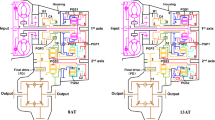Abstract
The automated mechanical transmission (AMT) is gaining popularity in the automotive industry, due to its combination of the advantages of mechanical transmissions (MT) and automatic transmissions (AT) in terms of fuel consumption, low cost, improved driving comfort and shifting quality. However, the inherent structural characteristics of the AMT lead to disadvantages, including excessive wear of the clutch plates and jerk and traction interruption during the shift process, that severely affect its popularity in the automatic transmission industry. The emerging technology of shifting control without the use of the clutch is a promising way to improve the shifting transients of AMTs. This paper proposes a control algorithm that combines speed and torque control of the AMT vehicle powertrain to achieve shifting control without using the clutch. The key technologies of accurate engine torque and speed control and rapid position control of the shift actuators are described in detail. To realize accurate engine speed control, a combined control algorithm based on feed-forward, bang-bang and PID control is adopted. Additionally, an optimized closed-loop position control algorithm based on LQR is proposed for the shift actuators. The coordinated control algorithm based on engine and shift actuator control is described in detail and validated on a test vehicle equipped with an AMT. The results show that the coordinated control algorithm can achieve shifting control without the use of the clutch to improve driving comfort significantly, reduce shift transients and extend the service life of the clutch.
Similar content being viewed by others
References
Feng, H. and Chen, X. (2009). Global robust optimal sliding mode control for brushless DC motor. Small & Special Electrical Machines, 37, 45–47.
Hu, S., Wang, Z. and Hu, W. (2005). Optimal Control Theory and System. Beijing.
Jia, H. B., Sheng, Z. S. and Yang, Z. L. (2003). Automatic control system of engine speed in series hybrid vehicles. J. Jiangsu University 24,1, 60–63.
Kong, J. H., Park, J. H., Lim, W. S., Park, Y. I. and Lee, J. M. (2006). Effects of the vehcle model on shifting transients of passenger cars with automatic transmission. Int. J. Automotive Technology 7,2, 155–160.
Lechner, G. and Naunheimer, H. (1999). Automotive Transmissions: Fundamentals, Selection, Design and Application. Springer. Berlin.
Liu, J. (2004). Advanced PID Control and MATLAB Simulation (2nd Version). Electronic Industrial Press. Beijing.
Luigi, G., Vladimiro, V. and Francesco, V. (2006). Gearshift control for automated manual transmissions. IEEE Trans. Mechatronics 11,1, 17–26.
Magnus, P. and Lars, N. (2000). Gear shifting by engine control. IEEE Trans. Control Systems Technology 8,3, 495–507.
Mashadi, B., Kazemkhani, A. and Lakeh, R. B. (2007). An automatic gear-shifting strategy for manual transmissions. Proc. IMechE Part I: J. Systems and Control Engineering, 221, 757–768.
Moon, S. E., Kim, H. S. and Hwang, S. H. (2005). Development of automatic clutch actuator for automated manual transmissions. Int. J. Automotive Technology 6,5, 461–466.
Pei, D. (2009). Research on the Integrated Control of No Separated Clutch AMT. Eng. M. Dissertation. Jilin University. China.
Wang, G. and Wang, L. (2007). The Bang-Bang principle of time optimal controls for the heat equation with internal controls. Systems & Control Letters 56,11/12, 709–713.
Wang, S. S. (2006). Engine Control of the Automatic Mechanical Transmission without Using Clutch. Eng. M. Dissertation. Jilin University. China.
Wang, Y. (2007). PWM regulating speed system of DC Motor. Market Modernization, 14, 389–393.
Wang, Y., Wang, Q., Xie, F., Wang, S. and Wang, J. (2010). Non-release-clutch technology of AMT for heavy duty truck. Automotive Technology, 5, 14–18.
Yu, G.-R., Tseng, M.-H. and Lin, Y.-K. (2004). Optimal positioning control of a DC servo motor using sliding mode. Proc. 2004 IEEE Int. Conf. Control Applications, 272–277.
Author information
Authors and Affiliations
Corresponding author
Rights and permissions
About this article
Cite this article
Zhong, Z., Kong, G., Yu, Z. et al. Shifting control of an automated mechanical transmission without using the clutch. Int.J Automot. Technol. 13, 487–496 (2012). https://doi.org/10.1007/s12239-012-0046-z
Received:
Revised:
Accepted:
Published:
Issue Date:
DOI: https://doi.org/10.1007/s12239-012-0046-z




